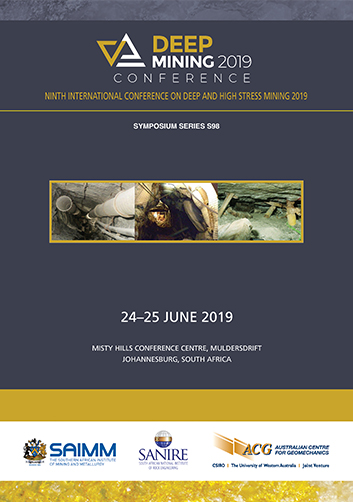Fracture model for rockburst mitigation based on the strain energy concept

|
Authors: Zepeda, R; Krstulovic, G |
DOI https://doi.org/10.36487/ACG_rep/1952_19_Zepeda
Cite As:
Zepeda, R & Krstulovic, G 2019, 'Fracture model for rockburst mitigation based on the strain energy concept', in W Joughin (ed.), Deep Mining 2019: Proceedings of the Ninth International Conference on Deep and High Stress Mining, The Southern African Institute of Mining and Metallurgy, Johannesburg, pp. 245-252, https://doi.org/10.36487/ACG_rep/1952_19_Zepeda
Abstract:
Rockbursts constitute an operational problem in deep excavations where many mitigation attempts using different methodologies were used without achieving workable, palliative strategies . The mitigation method with the highest number of bibliographic references is pre-conditioning of rocks prone to this phenomenon. Pre-conditioning seeks to lower the strength of the rock, ideally by increasing the number of fractures in it, and by extension, increasing its deformation response to imposed stress. The hydraulic fracturing technique or the use of explosives has been described in the literature as means to induce fractures in the rock mass just ahead of mining. The former method is the most popular in Chile. To date, there is not enough analytical explanation on how pre-conditioning can mitigate rockburst occurrences. In this paper, the laws of classic mechanics are described in terms of the strain energy to explain the pre-conditioning effect on the rockburst phenomenon; and arising from this, possible limitations of the hydraulic fracturing technique currently in use.
References:
Eberhardt, E. B. (1998). Brittle rock fracture and progressive damage in uniaxial compression. Saskatchewan, Canada: University of Saskatchewan. Obtained from .
Jaeger, J., C Cook, N. G., and Zimmerman, R. (1969). Fundamentals of Rock Mechanics. John Wiley & Sons.
Lianyang, Z., & Einstein, H. H. (2 de 2004). Using RQD to estimate the deformation modulus of rock masses. International Journal of Rock Mechanics and Mining Sciences & Geomechanics Abstracts, 41(2), 337-341. doi: 10.1016/S1365-1609(03)00100-X.
Palmstrom, A. (3 de 2005). Measurements of and correlations between block size and rock quality designation (RQD). Tunnelling and Underground Space Technology, 20(4), 362-377. doi: .
Priest, S. D. (1993). Discontinuity Analysis for Rock Engineering. Australia: Chapman & Hall. doi: .
Sirait, B., Wattimena, R. K., & Widodo, N. P. (2013). Rockburst Prediction of a Cut and Fill Mine by using Energy Balance and Induced Stress. (K. Matsui, & S. Kramadibrata, Edits.) Procedia Earth and Planetary Science, Volume 6, 426-434. doi: .
Talobre, J. (1957). La mécanique des roches: appliqué aux travaux publics. DUNOD.
Wang, J.-A., & Park, H. (2001). Comprehensive prediction of rockburst based on analysis of strain energy in rocks. Tunnelling and Underground Space Technology, 16(1), 49-57. doi: .
© Copyright 2025, Australian Centre for Geomechanics (ACG), The University of Western Australia. All rights reserved.
View copyright/legal information
Please direct any queries or error reports to repository-acg@uwa.edu.au
View copyright/legal information
Please direct any queries or error reports to repository-acg@uwa.edu.au